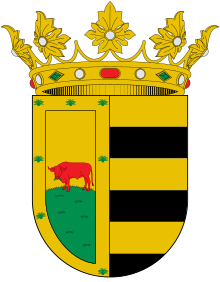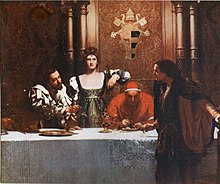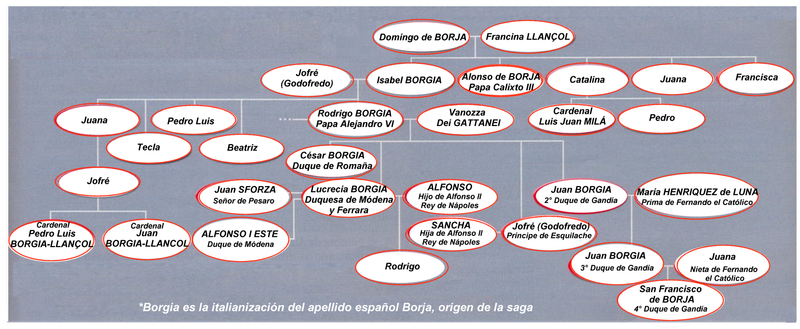Some members of the Family Alfonso Borgia (Pope Callixtus III) (31 December 1378–6 August 1458) Rodrigo Borgia (pope Alexander VI) (1 January 1431–18 August 1503) Pedro Luis de Borja Lanzol de Romaní (1472-1511) Pier Luigi de Borgia, 1st duke of Gandía ----- Giovanni Borgia (1474–14 June 1497) ------- Cesare Borgia (13 September 1475 or April 1476–12 March 1507) ---- Lucrezia Borgia (18 April 1480–24 June 1519) ---- Gioffre de Candia Borgia (1482–1522) ---- Giovanni Borgia (March 1498–1548) --- Saint Francis Borgia (28 October 1510–30 September 1572) --- Tomás de Borja y de Castro-Pinós ( 1551? - Zaragoza, 13 of September of 1610) --- Juan Buenaventura de Borja y Armendía (b. 1564 - d. 1628) --- Gaspar de Borja y Velasco (26 June 1580–28 December 1645) --- Francisco de Borja y Aragón (1581 — September 26, 1658) --- Ana Francisca de Borja y Doria (1640–1706) |
The Borgia family became prominent during the Renaissance in Italy.
They were from Valencia, the name coming from the family fief of Borgia, then in the kingdom of Aragon, in Spain.
The Borgias became prominent in ecclesiastical and political affairs in the 15th and 16th centuries, producing two popes, Alfonso Borgia who ruled as Pope Calixtus III during 1455–1458 and Rodrigo Lanzol Borgia, as Pope Alexander VI, during 1492–1503.
Especially during the reign of RODRIGO LANZOL BORGIA (Alexander VI), the Borgias were suspected of many crimes, including
-- adultery
-- simony
-- theft
-- rape
-- bribery
-- incest, and
-- murder (especially murder by arsenic poisoning).
Because of their grasping for power, they made enemies of the Medici, the Sforza, and the Dominican friar Savonarola, among others.
They were also patrons of the arts who contributed to the Renaissance.
Today, they are mainly remembered for their corrupt rule, and the name has become a synonym for treachery and murderers -- especially poisoners.
The Borgias emerged from Valencia in Spain.
There were numerous unsubstantiated claims that the family was of Jewish origin.
These underground rumours were propagated by, among others, Giuliano della Rovere, and the family was frequently described as marranos by political opponents.
The rumours have persisted in popular culture for centuries, listed in the Semi-Gotha of 1912.
Alfonso Borgia, later known as Pope Callixtus III (1378–1458), was born to Francina Llançol and Domenico Borgia in La Torreta, Canals, which was then situated in the Kingdom of Valencia.
Alfonso Borgia was a professor of law at the University of Lleida, then a diplomat for the Kings of Aragon before becoming a cardinal.
ALFONSO BORGIA was elected Pope Callixtus III in 1455, at an advanced age, as a compromise candidate and reigned as Pope for just 3 years.
Rodrigo Borgia studied law at Bologna.
Rodrigo Borgia was nicely appointed as cardinal by his Uncle Alfonso Borgia, Pope Callixtus III.
In turn, Rodrigo Borgia was elected Pope in 1492 under the name of Pope Alessandro VI.
While a cardinal, Rodrigo Borgia maintained a long-term relationship with Vanozza dei Cattanei of the House of Candia, with whom he had four children:
-- Giovanni Borgia.
-- Cesare Borgia.
-- Lucrezia Borgia and
-- Gioffre Borgia.
Rodrigo Borgia also had children by other women, including one daughter with his mistress, Giulia Farnese.
Rodrigo Borgia was recognized as a skilled politician and diplomat.
Rodrigo Borgia was widely criticized during his reign for his over-spending, sale of Church offices (simony), lasciviousness, and nepotism.
Rodrigo Borgia struggled to acquire more personal and papal power and wealth, ennobling and enriching the Borgia family directly.
Rodrigo Borgia appointed his son, Giovanni, as captain-general of the papal army, his foremost military representative.
Rodrigo Borgia established his son Cesare Borgia, as a cardinal.
Rodrigo Borgia used the marriages of his children to build alliances with powerful families in Italy.
At the time, the Sforza family, which
comprised the Milanese faction, was one
of the most powerful in Europe, so
Rodrigo Borgia united the two families by marrying
Lucrezia Borgia to Giovanni Sforza -- the marriage was later annulled.
----
Rodrigo Borgia also marries Gioffre Borgia, his youngest son from Vannozza, to Sancia of Aragon of the Kingdom of Aragon and Naples.
Rodrigo Borgia established a second familial link to the Spanish royal house through Giovanni Borgia's marriage during what was a period of on-again/off-again conflict between France and Spain over the Kingdom of Naples.
Rodrigo Borgia died in Rome in 1503 after contracting a disease, generally believed to have been malaria.
CesareBorgia was Rodrigo Borgia's second son with Vannozza dei Cattanei.
Cesare's education was precisely planned by his father.
He was educated by tutors in Rome until his 12th birthday.
He grew up to become a charming man skilled at war and politics.
He studied law and the humanities at the University of Perugia, then went to the University of Pisa to study theology.
As soon as he graduated from the university, his father made him a cardinal.
------
Cesare Borgia is suspected of murdering his older
brother Giovanni Borgia, but there is
no clear evidence to confirm this.
However, Giovanni Borgia’s death cleared the path
for Cesare Borgia to become a layman and gain the honors his brother received from their father, Rodrigo Borgia.
Although Cesare Borgia had been a cardinal, he left the holy orders to gain power and take over the position Giovanni Borgia once held: a condottiero.
Cesare Borgia was finally married to a French princess: Charlotte d'Albret.
After Rodrigo Borgia’s death in 1503, Cesare Borgia affected the choice of a next Pope.
He needed a candidate who would not threaten his plans to create his own principality in Central Italy.
Cesare Borgia’s candidate did become Pope, but he died a month after the selection.
Cesare Borgia was now forced to support Giuliano della Rovere.
The cardinal PROMISED Cesare Borgia that he could keep all of his titles and honours.
Later, della Rovere betrayed him and became his fiercest enemy.
Cesare Borgia died in 1507, at Viana Castle in Navarra, Spain while besieging the rebellious army of Count de Lerin.
The castle was held by Louis de Beaumont at the time it was besieged by Cesare Borgia and King John's army of 10,000 men in 1507.
In order to attempt to breach the extremely strong, natural fortification of the castle, Cesare Borgia counted on a desperate surprise attack.
Not only did he fail to take the castle, he was killed during the battle.
Lucrezia before the age of 13 was engaged to two Spanish princes, but after her father became Pope she was married to Giovanni Sforza in 1493 at the age of 13.
It was a typical political marriage to improve Rodrigo Borgia's power.
However, when Rodrigo Borgia did not need the Sforzas any more, the marriage was annulled in 1497, on the dubious grounds that it had never been consummated ("She was a virgin, and he was impotent" -- never proved).
Shortly afterwards, Lucrezia Borgia was involved in a scandal involving her alleged relationship with "Perotto", Spaniard Pedro Calderon.
Perotto's body was found in the Tiber on February 14, 1498
along with the body of one of Lucrezia's ladies.
It is likely that Cesare Borgia had them killed as an affair would have damaged the negotiations being conducted for another marriage.
During this time rumours were also spread suggesting that a child born at this time, Giovanni Borgia, also known as the "Infans Romanus", the child of Rome, was Lucrezia Borgia's.
---------
Lucrezia’s second marriage was to wealthy Alfonso, principe d'Aragon.
This marriage allowed the Borgias to form an alliance with another powerful family.
However, this marriage did not last long either.
Cesare Borgia wished to strengthen his relations with France and completely break with the Kingdom of Naples.
As Alfonso's father was the ruler of the Kingdom of Naples, Alfonso was in great danger.
Although the first attempt at murder did not succeed, Alfonso, principe d'Aragone,
was eventually strangled in his own quarters.
Lucrezia Borgia's third and final husband was also called Alfonso: Alfonso I D'ESTE, Duca diFerrara.
After Rodrigo Borgia died in 1503, Lucrezia Borgia lived a life of freedom in Ferrara with her husband and children.
Unfortunately, Lucrezia's pregnancies were difficult and she lost several babies after birth.
She died in 1519, 10 days after the birth and death of her last child, Isabella Maria.
Lucrezia Borgia is buried in a tomb with Isabella and Alfonso.
The Borgian era, or the time period when the Borgia family had its greatest influence, started in the early 16th century, about the time of the death of Lucrezia in 1519.
The Borgia family had influence during the age of the Renaissance and the beginning of the Age of Discovery.
This was the era of many artists, writers and rulers who have influenced the modern age.
Gioffre Borgia (1482-1516), son of Pope Alexander VI and younger brother of Cesare Borgia and Lucrezia Borgia, married Sancia of Aragon, daughter of Alfonso II of Naples, obtaining as dowry both the Principality of Squillace (1494) and the Duchy of Alvito (1497).
----
Although Gioffre was deprived of Alvito after the death of Sancia in 1506, he managed to retain Squillace.
He subsequently married Maria de Mila, and passed it on to their son Francesco Borgia.
----
The Borgia Princes were: Gioffre, Francesco, Giovanni, Pietro and finally Anna e Donna Antonia Borgia D’Aragona on whose death, in 1735, it passed to Bourbon Kings of the Two Sicilies.
Living either in Naples or Spain, the Borgias ruled their fief through governors.
Not all of the Borgias were corrupt or violent.
Francesco Borgia (1510–1572), a great-grandson of Rodrigo Borgia, did not follow his relatives.
He had fathered a number of children and after his wife died, Francesco determined to enter the Society of Jesus, recently formed by Saint Ignatius of Loyola.
As a reward for his efforts, the Church canonized the Jesuit Francesco on 20 June 1670.
Another Borgian who lived after the Borgian era was Gaspar de Borja y Velasco (1580–1645).
Unlike many of his relatives, Gaspar preferred to use the Spanish spelling of Borgia: Borja.
He was born at Villalpando in Spain.
He was related to both Pope Callixtus III and Pope Alexander VI, and some historians believe that Gaspar wished, like his relatives, to become Pope.
He served as Primate of Spain, Archbishop of Seville, and Archbishop and Viceroy of Naples.
Currently, the only patrilineal family Borja or Borgia (Duke of Gandia, papal lineage straight from John Borja and Cattanei) is found in Ecuador and Chile.
One of his prominent descendants is Dr. Rodrigo Borja Cevallos, former left-wing president of Ecuador (1988-1992).
Another branch of the family, the descendants of Cesare's illegitimate son, Girolamo Borgia can be found in Slovenia.
There are many controversies connected with Rodrigo Rorgia.
He was not only accused of simony and nepotism, but also of
attending public orgies, along with his
daughter Lucrezia.
Donizetti puns on this:
B - O - R - G - I - A ---> O - R - G - I - A
The "Banquet of Chestnuts" (also called the "Ballet of the Chestnuts") is considered one of the most disreputable balls of this kind.
It was held on October 30, 1501.
Not only was Pope Alexander VI present, but also two of his children, Lucrezia Borgia and Cesare Borgia.
Rodrigo Borgia is also remembered for other crimes, many of them including torture and execution.
The famous Florentine preacher Savonarola was executed under Rodrigo Borgia's reign.
-----
Savonarola accused Rodrigo Borgia of corruption and called for his removal as Pope.
Savonarola was tortured and then hanged and burned publicly.
Rodrigo Borgia is also remembered for bringing his mistresses to the papal court.
One of them, Vanozza Cattanei, gave him four children -- Giovanni Borgia, Cesare Borgia (who killed Giovanni), Lucrezia Borgia, and Gioffre Borgia -- and another two children were born by Giulia Farnese: Tom Borgia-Farnese and Jerry Borgia-Farnese.
Rodrigo Borgia took Giulia Farnese as his mistress when she was a fifteen-year-old girl and he was over 60.
After Cesare Borgia became a leading general of the French King Louis XII, he conquered a number of lands.
-----
When Lucrezia Borgia’s second husband, Alfonso, the Duke of Bisceglie, was no longer important to the Borgias, Cesare Borgia strangled him when he was still recovering from another attempt of assassination on his life.
The first attack was also most likely organised by Cesare Borgia and his men.
Between 1501 and 1503 Cesare Borgia hired Leonardo da Vinci as military architect and engineer, which means that Leonardo da Vinci helped him conquer and then fortify fortresses.
It is said that Leonardo invented war machines for Cesare Borgia and Leonardo da Vinci received protection in return.
Cesare Borgia allowed Leonardo da Vinci to have full control over all planned and ongoing construction in his domain.
Thanks to Leonardo da Vinci’s merits, he received a vineyard from the family, which he later had to abandon, because of the fall of the Borgia empire.
When Leonardo da Vinci completed his work for Cesare Borgia, he had difficulties finding another patron in Italy.
Finally, Francis I of France was able to convince him to enter his service, where Leonardo would work for the final three years of his life.
Some historians say that Cesare Borgia murdered his older brother Giovanni Borgia.
However there is no clear evidence that he actually did.
There is also the case of "Perotto", a chamberlain, and Lucrezia's lover.
When Cesare Borgia found out about her sister Lucrezia Borgia’s pregnancy (to "Perotto") he was so furious that he had the father of the child murdered.
The body of Perotto was fished out of the Tiber.
Also, the body of a chambermaid was found in the river.
The chambermaid was murdered for giving Lucrezia Borgia and Perotto a chance to meet in secret.
Both murders were commissioned by Cesare Borgia.
Johann Burchard, a contemporary of Rodrigo Borgia, who lived in the Vatican, states about Cesare Borgia.
One day,
Cesare Borgia went so
far as to have the square of St. Peter enclosed
by a palisade, into which he ordered some
prisoners — men, women and children —to be brought.
Cesare Borgia then had the prisoners bound, hand and foot, and being armed and mounted on a fiery charger, commenced a horrible attack upon them.
Some prisoners Cesare Borgia shot.
Others Cesare BOrgia cut down with his sword, trampling them under his horse's feet.
In less than half-an-hour, he wheeled around alone in a puddle of
PUDDLE OF BLOOD, among the dead bodies of his victims, while his Holiness Rodrigo Borgia and Madam Lucrezia Borgia, from a balcony, enjoyed the sight of that horrid scene.
-----
Lucrezia Borgia was rumoured to be a notorious poisoner and she became famous for her skill at political intrigue.
However, recently historians have started to look at her in a more positive light.
She is often seen as a victim of her family’s deceptions.
It is believed that Cesare Borgia and Lucrezia Borgia committed incest.
Portraits of the Borgia
- Rodrigo Borgia
(AlessandroVI) father of Lucrezia, Cesare, Giovanni, and Gioffre. - Cesare Borgia
Duca di Valentinois
--- main character in Leoncavallo's "Cesare Borgia" -- terza parte della trilogia storica rinascimentale, "Il creposcolo". - Lucrezia Borgia
Duchessa di Modena e Ferrara
-- Felice Romani, "Lucrezia Borgia", tratto da Vittore Ugo.
The Borgias were infamous in their time, and inspired numerous references in popular culture including novels, plays, operas, comics, films, television series and video games.
Borgia by Mickael Zevaco
The Borgias by Alexandre Dumas, père.
Compilation of music associated with the Borgias. Hespèrion XXI, Jordi Savall.
- Assassin's Creed II (2009), Ubisoft
- Assassin's Creed II: Discovery (2009), Ubisoft
- Assassin's Creed: Brotherhood (2010), Ubisoft
- Assassin's Creed: Revelations (2011), Ubisoft
See also [edit]
Notes:
^ Arsenic: A Murderous History. Dartmouth Toxic Metals Research Program, 2009
^ The Menorah journal, Volumes 20-23, Intercollegiate Menorah Association, 1932, page 163
The Borgias: or, At the feet of Venus, Vicente Blasco Ibáñez, P. Dutton & Co. Inc., 1930, pages 242, 313
^ Lucrezia Borgia: Life, Love and Death in Renaissance Italy, by Sarah Bradford
^ "Francis Borgia (1510–1572).". 2012Thames & Hudson Dictionary of the Italian Renaissance, The. London: Thames & Hudson, 2006.
^ Bradford, Sarah (Reprint edition 2005). Lucrezia Borgia: Life, Love and Death in Renaissance Italy. Penguin. pp. 67–68. ISBN 978-0143035954.
^ "Borgia, Lucrezia (1480–1519).". The Penguin Biographical Dictionary of Women. London: Penguin, 1998.
^ "Francis Borgia (1510–1572).". Who's Who in Christianity, Routledge. London: Routledge, 2001.
^ Lucrezia Borgia: A Biography. Rachel Erlanger, 1978
References:
External links
- Centropolis.homestead_Library
- 1494: How a Family Feud in Medieval Spain Divided the world in Half
- (Spanish) Borja o Borgia
- (Spanish) Francisco Fernández de Bethencourt - Historia Genealógica y Heráldica Española, Casa Real y Grandes de España, tomo cuarto
- (Spanish) Una rama subsistente del linaje Borja en América española, por Jaime de Salazar y Acha, Académico de Número de la Real Academia Matritense de Heráldica y Genealogía
- (Spanish) Boletín de la Real Academia Matritense de Heráldica y Genealogía
- (Spanish) La familia Borja: Religión y poder. Entrevista a Miguel Batllori
- (Spanish) La mirada sobre los Borja (Notas críticas para un estado de la cuestión)
- The Borja Family: Historiography, Legend and Literature by Eulàlia Duran, Institut d’Estudis Catalans




















No comments:
Post a Comment